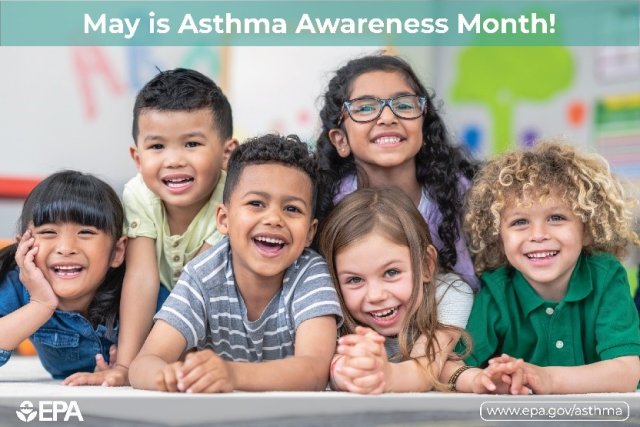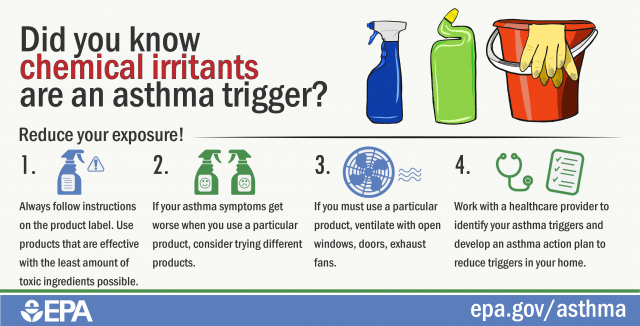Asthma and Your Health
World Asthma Day was on May 6, 2025. May is also Asthma Awareness Month! Explore the resources on this page to learn what asthma is, how air quality affects people who have asthma, and how to manage environmental asthma triggers to improve quality of life.
On this page:
Asthma Awareness Month

May is Asthma Awareness Month, a time to educate friends, family, and patients about asthma and promote awareness about how this disease can be controlled. During Asthma Awareness Month, EPA provides ready-to-use tools and resources for promoting asthma awareness in your community. Every year, Asthma Awareness Month is kick-started by World Asthma Day on the first Tuesday in May.
How can I get involved?
- Download our Asthma Awareness Month Event Planning Kit (pdf) for ideas and helpful tips for running asthma events in schools, hospitals, clinics, and other parts of your local community.
- Raise asthma awareness on social media using any of the materials below. Use the hashtags #asthma, #AsthmaAwarenessMonth, and/or #WorldAsthmaDay.
- Share any of the following asthma triggers infographics during Asthma Awareness Month and download an example asthma action plan.
- Parents, caregivers and teachers can share the Dusty the Asthma Goldfish @Funbook with kids so they can learn more about asthma triggers.
- Join the Asthma Community Network and learn about how to finance in-home asthma care.
- Explore asthma resources from our federal partners to learn about efforts from other federal agencies, national nonprofit organizations, and EPA regional offices working to advance asthma care through outreach and education on environmental asthma triggers.
Test Your Knowledge 1
A. The correct answer is True
Hey... No Peeking!
You need to select an answer to the question before we'll show you the right answer...
Asthma and Schools
Asthma is a long-term disease that inflames and narrows your lungs' airways. Have you ever tried to breathe through a flat straw? It makes breathing harder and can be scary. That's how people who have asthma can feel when they are exposed to pollutants like dirty air, whether it's from ozone, wildfire smoke or other pollution.
Why is the air quality in schools important?
Nearly 1 in 13 school-age children has asthma, which is the leading cause of school absenteeism due to chronic illness. There is substantial evidence that indoor environmental exposure to allergens (such as dust mites, pests, and molds) play a role in triggering asthma symptoms. These allergens are common in schools. There is also evidence that exposure to diesel exhaust from school buses and other vehicles exacerbates asthma and allergies. Visit the Creating Healthy Indoor Air Quality (IAQ) in Schools website for more information.
What steps can schools take to improve indoor air quality?
The IAQ Tools for Schools Action Kit teaches schools how to carry out a practical plan to improve indoor air problems at little- or no-cost using straightforward activities and in-house staff. The Action Kit provides best practices, industry guidelines, sample policies, and a sample IAQ management plan.
Test Your Knowledge 2
B is the correct answer.
Hey... No Peeking!
You need to select an answer to the question before we'll show you the right answer...
Test Your Knowledge 3
B. The correct answer is False
Explanation: Asthma is a lifelong disease. Some children may have fewer symptoms in their teens but they still have asthma. To learn more, visit https://www.epa.gov/asthma/do-children-outgrow-asthma
Hey... No Peeking!
You need to select an answer to the question before we'll show you the right answer...
Environmental Asthma Triggers
What are indoor environmental asthma triggers?
Americans spend up to 90% of their time indoors, and indoor allergens and irritants play a significant role in triggering asthma attacks. Triggers are things that can cause asthma symptoms, an episode or attack, or make asthma worse. Some examples of triggers are secondhand smoke, dust mites, and molds. If you have asthma, you may react to just one trigger or you may find that several things act as triggers. Be sure to work with a doctor to identify triggers and develop a treatment plan that includes ways to reduce exposures to your asthma triggers.
To learn more about asthma triggers and how you can reduce your exposure to triggers, visit EPA's Gain Control webpage.
Download this collection of asthma triggers infographics that provide a brief overview of different kinds of asthma triggers and ways to reduce exposure:

Test Your Knowledge 4
D is the correct answer.
Hey... No Peeking!
You need to select an answer to the question before we'll show you the right answer...
Burn Wise
What is EPA's Burn Wise program?
The Burn Wise program promotes the importance of burning the right wood, the right way, in the right appliance. The more efficiently you burn wood (e.g., using an EPA-certified wood stove and dry, seasoned wood) the less smoke is created.
Why is burning the right wood, the right way, in the right appliance important?
Smoke may smell good, but it's not good for you. The biggest health threat from smoke is from fine particles, also called fine particulate matter or PM2.5. These microscopic particles can get into your eyes and respiratory system, where they may:
- Cause burning eyes, runny nose, and illnesses, such as bronchitis.
- Worsen and trigger asthma attacks.
- Trigger heart attacks, stroke, irregular heart rhythms, and heart failure, especially in people who are already at risk for these conditions.
Download the Wood Smoke and Your Health poster today.
What resources should I explore before I burn?
- The Health and Safety Awareness Toolkit encourages safe and efficient wood burning practices during the heating season.
- Burn Wise Best Practices Videos cover how to store firewood, how to get the best burn from your firewood, tips for a long-lasting burn, and more.
Healthy Heart
Asthma is not the only adverse health outcome experienced from poor air quality exposure.
Did you know...
Heart disease and stroke are the first and fourth leading causes of death in the U.S.
Air pollution can affect heart health and can trigger heart attacks and strokes that cause disability and death in those predisposed.
One in three American adults has heart or blood vessel disease and is at a higher risk from air pollution.

